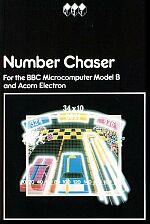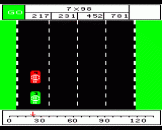Blurb
Since calculators have become such common household objects, fewer people now resort to mental arithmetic. Children brought up on calculators may never acquire a feel for numbers. When multiplying using the calculator, they have no idea what size answer to expect, and may well make a mistake, arriving at a value that is much too large or too small without even realising.
Number Chaser is a race game, featuring advanced graphics and a choice of four different vehicles, corresponding to four levels of difficulty. You race against the computer's car, all the time estimating the answers to a series of multiplication sums. You may be able to win the race, but can you make it to world champion? Ages 5-12.
In All ASK Programs
|
|
Remember: once you have typed in your response a program will deal with it until you press the RETURN key. |
|
|
You can always return to the beginning of a program by pressing the ESCAPE key. |
|
|
You can rub out anything typed in, before the RETURN key is pressed, by using the DELETE key. |

|
Means : Please press the space bar to carry on with the program. |

|
Means : the program did not expect the response it has just received. Perhaps there was a typing error? In any case, to carry on, just press the space bar and try again. |

|
All of our programs incorporate sound. There are various volume levels - holding down the CTRL key and pressing the S will change the level - keep pressing the keys until you are happy with the volume. |
Introduction
Calculators are now inexpensive items and most households will have at least one. As a result, fewer people now resort to pen and paper, or do arithmetic in their heads. This means that children are less likely to develop a "feel" for numbers. There are particular problems with multiplication, in that the child may have no idea of what size the result is going to be. An extra nought inadventently introduced may mean the answer is ten times larger or smaller than the correct one, and this may pass unnoticed.
Number Chaser is designed to develop those skills of estimation that children may not acquire when frequently using a calculator.
The game is a race between the player's vehicle and an opponent's vehicle (which pursues the former). In fact both vehicles are controlled by the player's performance: Enough correct answers, and the player wins the race, too many worng answers and the vehicle behind will crash into yours.
How To Use
When you have loaded Number Chaser, the program will start by asking you to choose what sort of vehicle you want to race with. The bicycle will give you the easiest problems and the racing car will give you the hardest. If you haven't played before, then it's best to start off on a bicycle. Choose the vehicle you want by pressing a, b, c or d and then the RETURN key.
You are now asked if you want to play using the keyboard or a joystick. Decide which you want to use, press 1 or 2 and then the RETURN key. if you are using the joystick, remember that it must be plugged into the "analogue in" socket in the back of your BBC.
The screen now shows a four lane race track. There are two vehicles on the track, one behind the other. The spacebar symbol appears. Press it, and you will see a multiplication sum at the top of the screen. Just below it are four numbers, one above each lane on the race track. These are the choices you've got as possible answers to the sum at the top. None of them are the correct answer, but one is closer to the correct answer than the other three. Estimate the answer, and decide which of the four numbers is closest to it. Now you must move your vehicle into the correct lane. If you are using the joystick move your vehicle by going left or right. If you are using the keyboard, just use the Z and X keys (left and right) to move the vehicle from lane to lane. As you move across the track, you will notice that the other vehicle is following you.
After a pause, the correct answer will flash. If your choice of the nearest answer was right, the speed of your vehicle will increase, and you will get further ahead of the other vehicle. You will now see another sum appear. Estimate the answer and choose the number closest to it, as before.
If your answer was not the nearest one to the sum's solution then the spacebar symbol appears; this will give you a chance to see what the nearest number to the sum's solution was. Check what it was that you did wrong. When you are ready, press the spacebar and you will be given a new sum. Watch out though, because your vehicle will have slowed down, and the computer's vehicle will be catching up with you!
The race can end in one of two ways: either you win by getting your vehicle right to the top of the screen, at top speed, or the computer's vehicle crashes into you - if you have let it catch up with you. If you win, the crowd come up to you, clapping their hands. The spacebar symbol will then appear. Press it when you are ready, and you will see the scorecard. This will show you your average speed and the level you reached. Can you become a world champion on your class of vehicle?
After the race has finished, press the spacebar to return to the beginning of the game.
Educational Notes
Most work in school 'paper and pencil' mathematics schemes reward the child who can plod meticulously through the mechanics of number manipulation, without any real idea of what the final answer should be like. Estimation, on the other hand, requires a quick grasp of the essentials of the problem, and the ability to round off numbers correctly in order to calculate an answer which gives the child a 'picture' of the kind of number which is a viable solution. This is a very important, but neglected skill, as it is very difficult to implement in the classroom using traditional teaching methods. Number Chaser is a game which is designed to try and fill this gap and which is fun both at home and at school.
In the classroom Number Chaser should be used alongside traditional or computer aided methods of learning tables, as a valuable extension of the work. It will be found that many children will select this program as an enjoyable game to play in their free time, acting as an incentive for them to develop their tables knowledge and estimation skills outside of the classroom situation.







